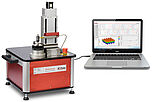
M-Scan Rotory
Compact Quality Control in Lab and Production!

Measurement principle
The measurement device is using a Hall sensor perpendicular to the direction of the rotor magnetic field. Turning the rotor along the Hall sensor can be contemplated as an "unwinding" of the rotor flux density in a graph of the total radial component of the rotor flux density along the rotor circumference. Using a rotary encoder, the measured signal is independent of the rotary speed resulting in a spatially resolved direction of the rotor flux density. All poles can be examined separately.

Why choosing a Rotor-Scan?
- Check the quality of your magnets
- Detect errors during the assembly of the lamination stack
- Detect influences caused by inhomogeneity of the laminated core
- Check position of the lamination stack to the shaft
- Detect the strew field magnetization

Software testing criteria
- local and global pole peak detection
- Flux density in pole center
- Pole width
- Pole integrals
- Harmonic analysis
- Pole skewing
- Total flux
- Pole comparison

Integration
Available as a version for integration into your production line.
M-Pulse supplies all the hardware components to be integrated and our analysis software.


